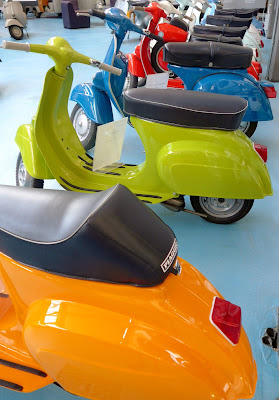'Walk Through British Art' is a series of galleries at Tate Britain which in their words is, "...a walk through time", through their collection from 1545 to the present. "There are no designated themes or movements; instead, you can see a range of art made at any one moment in an open conversational manner."
Fuelled by lunch, having seen the Barbara Hepworth exhibition, which you can read about here, we headed into the permanent galleries. I watched and chatted to my kids, intrigued to see how the Tate's 'open conversational manner' approach to displaying art worked itself out in our conversation.
What made them tick in the Tate?
Materials
Quite often it was the materials and the questions surrounding their use that drew in the kids, especially my youngest son and his friend.
Such as bread.
"Bread people".
"Do you think he bought sliced bread?"
"How did he cut the bread to make room for the body shape? Did he cut round someone or use a mould of a person?"
"Bet it smells."
"I want to climb on them." Fortunately at 12 years old, he knew better.
Puzzles
Sometimes it was the challenge of a piece of art that captured the kids' imagination. Especially if the work presented itself as a bit of a puzzle.
Art in corners.
"I really can't tell if those shapes are printed on the wall or hanging there."
This was one of those pieces of work in a gallery that make you go and get your mum.
"Can I show you something really cool?"
"That's mad."
"That's not a hole is it? There's no way that's a hole."
We were so close, yet couldn't tell. Clever!
"Mum look, 3D or not 3D." He was pleased with himself for the pun.
Familiarity
We all like the work that reminded us of something, something within our experience.
"Do you remember seeing that Gilbert & George exhibition in Exeter?"
"That looks like Britain overcoming the Nazis in the Second World War. They start to break up, then at the end they are shattered apart."
We look at the label and find out that this was in fact made in the seventies. It is though, a comment on racism.
"Racism is breaking down. Good."
"I've seen this before. I like the colours, the splash." Says a teenager unafraid of colour.
"What even those greys?"
"Grey's not a horrible colour. You wear a lot of grey." True.
"I recognised that from the airport. I saw a security camera and the inside of a suitcase looked liked that."
Kids seem to want a work of art to be about something.
"What's this meant to be?"
"It's meant to be art."
"But what's it all about?"
So when no "about" is mentioned, they start to decide for themselves, more often than not applying concrete rather than abstract concepts.
"It looks like a ship."
"They look like singing worms."
"Friendly creatures."
"What is it about them that makes them look friendly?"
Hard Work
Hard work is acknowledged and respected.
"Those words must have taken a long time to do, especially if they did it manually", says a child from a digital age.
What they didn't get.
"How is that a work of art, it just looks like a messy room."
"That is not someone with a good life because they have mess all over their bed, things you don't really need. If they had a good life, they'd have a bedside light and loads of books."
The comments of two boys, not yet teenagers, on a comment made by the artist on her own life.
" Do you think Tracy Emin has bedside light nowadays?"
Having a bedside light obviously says a lot about a person.
At this point, two delighted boys find and show us the smallest spider web, connecting her bedside table to her mattress. The Tate has a squatter, do they know? Does Tracy Emin know?
"What's the point? It's not saying anything important."
"It's a wire sculpture. Like a wire drawing. Sometimes when you draw, you make more than one line don't you. I think it's beautiful, a gentle, soft, wire drawing."
This was our conversation, Whether or not our responses were what the artists or Tate imagined, it's what we talked about. We would have liked a bit more "about" conversation with the Tate. When you're nine and twelve years old, it's important that galleries answer some of your questions. I reckon the Tate could have joined in a little more with the conversation, information was sparse.
As you can see, kids do get on with it, get engaged, make comments and stop themselves climbing on some very tempting pieces of sculpture, but at times things can come to a dead end.
"I don't know what it's supposed to be."
Tate Britain, Walk Through British Art galleries is free, open every day. What's stopping you visiting?
Unless you're scared of spiders.
Details on their website here.
Just in case you were wondering. It was a hole. I can't tell you how we found out, but I promise we did not touch the artwork.
UPDATE: To answer my son's questions about how Anthony Gormley cut the bread for the body shape in the sculpture above, We have since found out (from the telly) that he ate all the bread required to to make a 3D outline of himself.

































































